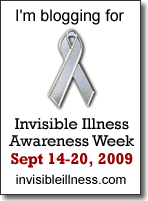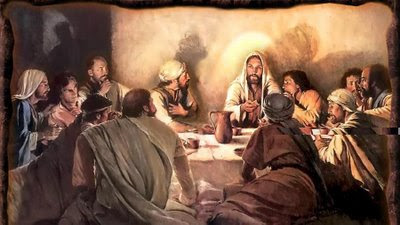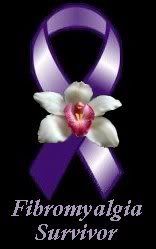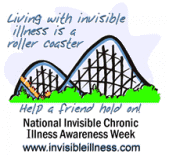Invisible Illness Awareness & Support
Blog tours are when a person asks bloggers to post an interview on their blog, to increase awareness of a certain issue or product. I am very honored to be included in this endeavor. Her websites have sustained me, helped me grow in my relationship with the Lord, and put me in contact with very spiritual people who have learned wisdom through thier struggles, and can pass that wisdom on to others. Through them, I have learned so much that I would never have figured out alone in a lifetime alone, so I am now able to reach out to others who are quite new to the world of chronic illness, and so the circle continues. The student
soon becomes a teacher.
That is where I spend most of my time, getting counseled and offering counsel from others who are suffering, and we help each other get farther away from worldly things, and closer to eternal concepts. Through sheer necessity, we get closer to the Lord, because of our need to constantly leean on Him. We learn to not only talk to Him, but to listen for the answers. He will answer our prayers. James 1:5 says"
"If any of you lack wisdom, let him ask of God,
who gives to all men liberally,
and does not hold back; and it shall be given him."I believe people with physical limitations have no choice but to spend more time "Being still, knowing that He is real." That is one benefit of being slowed down, to be able to learn to listen to the answers (There are actually many blessings and benefits that come from hardships.)
I can't find the scripture I want, but one says we will be shown the mysteries of the universe if we are willing to ask and to learn to listen and recognize the voice of the Holy Spirit and the Savior and the Father.
It is a great feeling to know that even though we are limited physically, we can still be useful, we can still feel needed, by helping others online. We contineu to learn as we help others. Before the days of internet, I can't imagine how people surivived emotionally or physically for very long through serious illnesses that would make them shut-ins. How isolated and lonely they would be! I am so grateful to live in the age of Internet so the Lord can send me wise and loving friends from all over the world, and they are available at my fingertips. Now, to introduce you to a great influence in my life (and hundreds of thousands of others),Lisa Copen.
Copen joins us today as the founder of http://www.invisibleillnessweek.com/ .
LC: Thanks for having me. I've had a great time getting to visit so many incredible blogs that cover such a variety of health and illness topics.
Even I have been surprised just how many there are, and the quality of them. Both readers and writers of blogs have made such a difference for people who live with illness.
I appreciate all of the bloggers who bring more awaremess amd familiarity, not just to illnesses and conditions, but to who the people are who live with the constant "daily-ness" of chronic pain or health issues.
Sheila: Yes, those who struggle with constant pain and fatigue seem to be a deep-thinking, quality type of spirit. Speaking of awareness, tell us about National Invisible Chronic Illness Awareness Week. That's quite a mouthful!
LC: I know. You'll often hear it described as just Invisible Illness Week too. Our mission is to have a designated time, worldwide, in which
people who live with chronic illness, those who love them, and organizations are encouraged to educate the general public, churches, health care professionals and government officials about the affects of living with a disease that is not visually apparent.
Through programs and resources, we seek to recognize the daily challenges of more than 100 million adults and children who live with invisible illness. Its also a great chance for people with any illness to be involved in a national event to increase the under-standing of their own particular disease. They can use our event to blog about the emotions of living with their illness, for example, how they often may look perfectly fine, but are in deep pain.
Sheila: Tell us about this virtual conference.
LC: The virtual conference is a unique opportunity to attend a conference without having to get out of your pajamas! The main event of National Invisible Chronic Illness Awareness Week is this 5-day virtual conference--which is all completely free--September 14-18. We have 20 speakers who are experts in chronic illness and their specific area and each will be giving a 40-minute seminar and then taking calls from our listeners live. The seminars are M-F, 4 times a day, and will feature a variety of topics such as going to college, the challenges of marriage, applying for disability financial assistance, cleaning and organizing, finding the right job, faith, preparing for surgery, parenting, and many more. You can listen to them all free live, or later on your computer, even download them from itunes. Or they can be purchased on a CD.
Sheila: Really? So are last years programs available too?
LC: They are. We used a chat room originally so we had written transcripts, but one can ALSO hear 2008's programs from a computer, itunes, or purchased on a CD.
LC: Isn't it? It's kind of ironic that we began virtual conferences years ago, but now many organizations and companies are making this a trend because of the economy and costs of a real conference
Sheila: Why did you see Invisible Illness Week as something that was needed? What made you decide to start this program?
LC: Well, a few reasons. I began Rest Ministries in 1997. It's a Christian organization
that serves those who live with chronic illness and the sponsor of Invisible Illness Week. I kept seeing many people who felt very alone, misunderstood, and frustrated, feeling that their illness, pain, and suffering were completely invalidated. Many people have a spouse who even doubts the existence of an illness.
Then I also heard from family members of those who are ill, pastors, caregivers, and even doctors who really wanted to communicate better with those who dealt with chronic pain and just didn't know what to say or how to say it. They may have tried to say the right thing, but it ended up coming out from so they would just withdraw from the relationship. The fact that illness and pain is invisible to see can make it hard for healthy people to understand. And those with illness can easily become bitter when their loved ones believe it is being exaggerated. It makes for a sad situation all the way around and I thought communication could be a helpful first step.
Sheila: This sounds familiar. I've heard many people say this.
LC: Yes, sadly it does, doesn't it? Even those of us who say we cope well on a day-to-day basis with our chronic illness can suddenly be overwhelmed with the emotions when we legally parked in a disabled parking spot and someone walking by gives us "the look" of skepticism. Or perhaps one of our dearest friends unknowingly asks, "So, you must be feeling a lot better by now, right?" There is a difference between being sick with a cold virus and being chronically ill. With a chronic illness you don't get "all better", but instead you go through the seasons of the illness. This difference is hard to grasp what you've never tell with a chronic condition.
LC: Yes, I wanted to bring people together to encourage one another. I saw people hurting when they had every reason not to and I knew they could encourage others. It really doesn't matter what illness we have, where we live, what age we are, how long ago we were diagnosed, etc. The fact that most of our illnesses are invisible and not seen by people gives us a lot more in common that most of the physical symptoms of our specific illnesses ever could.
Sheila: What illness do you have, Lisa?
LC: I was diagnosed with rheumatoid arthritis in 1993, at the age of 24. A few years after that, fibromyalgia. I've never been in remission, so I have had a difficult time of it, though I know it could have been worse. Each day is a challenge and I am on multiple medications to just try to have some quality of life and keep walking. My hands and feet are pretty deformed now and I have many surgeries in my near future. My illness has gone from being completely invisible to much more visible and it's not just the pain that bothers me now but the loss of being able to do things, or do them with ease. Driving or unloading the dishwasher is an event because of my hands. Suddenly stepping off a curb is a challenge.
Sheila: How can people get involved with Invisible Illness Week and find out more information?
LC: Thank you for asking because just by helping us spread the word, for example,
sharing about this blog post or by linking to it or posting it on Facebook, is the perfect ways to help our grassroots cause. I probably don't have to tell you that we don't have a marketing budget! When people introduce their friends or family to our virtual conference or tweet out our twitters or articles, they are making a significant difference. We also have some fun items to help spread the word like buttons, and tote bags, silicon bracelets that say "Invisible Illness, Visible Hope," awareness pins, and of course bumper stickers.
Our theme this year it is "A Little Help Gives a Lot of Hope." We are also accepting blogs from people to be featured on our site as a guest blogger. And we have a place to sign up to commit to blog on the topic of invisible illness on one's own blog. You can join our cause on Facebook and share it with others, tell people about our video, our twitter facts about illness, things like that. Tell your doctor, counselor, pastor, colleagues; we have brochures available too.

Sheila: How has blogging and twittering and other forms of social media made a difference? Has it helped in how you've been able to let people know about Invisible Illness Week?
LC: Yes! So much, it's unbelievable. It's given every person who is interested in letting people know about what is important to them (like increased awareness about an illness) a forum. We've sent out some series of tweets in the forms of lists, like 20 things to say to a chronically ill person, illness facts, 20 things not to say, etc. with the twitter hashtag #iiwk09. There have been some really deep conversations at places like Facebook, spurred on from our posts. Be sure to follow us @invisibleillwk on Twitter!
Sheila: I know there are a lot of people who feel so utterly alone, as if no one understands what they are going through. What do you tell these people?
LC: Honestly, if I could just sit beside them and give them a long gentle hug, I would do that first. I struggle with just listening myself; I always want to start solving the problem! But I know someone to listen to them is what most people really need. Secondly, I would also validate that they are right--no one can really can understand what they are going through. Illness is a unique and lonely experience. That said, there are a lot of ways to connect with people who understand more than they may expect; they just have to find them. There are lots of ways online to connect when you can't drive to a support group. Our social network is Rest Ministries Sunroom and I recently began Illness Twitters to connect people who Twitter about illness or health issues.
And lastly, since my faith is in the Lord, I couldn't let them walk away without sharing how knowing God has a plan for my life, despite my illness, has kept me going. I would want to tell them that despite any bad experiences they may have had at churches or with other Christians, God still has a "Plan A" for their life. The illness hasn't bumped them down to
"Plan B." That all may sounds cliche. I know that. But every day I hear people who say their faith in God is the only thing that gets them through it.
Sheila: You have a book out that gives people ideas about how to help a chronically ill friend, don't you?
LC: Yes, its called "Beyond Casseroles: 505 Ways to Encourage a Chronically Ill Friend." It's a helpful book that I refer to for ideas, even though I wrote it, because when someone I care about is hurting it is hard to think beyond bringing them food. We also have cute little JOY cards that stand for "Just Offering You..." that look like a gift certificate. A person can fill it out with what he or she is able to do like running an errand or doing laundry.
Sheila: That's a terrific idea! I would imagine that it would be easier to accept help from someone if it looked like a gift certificate.
LC: I think so. The cards are great for a support group, a womens ministry, or really anyone who wants a light-hearted way of saying, "I'd love to help. Here is what I am able to do."
Sheila: As a person who suffers from an invisible illness, what is the best way to react when people around me comment that I look fine, (therefore, in their mind I must be faking my illness)?
LC: That is a hot topic isn’t it? We have a few posts on our web page where people have addressed this question too. I think that it depends on your relationship with the person. Is this someone close to you who you feel comfortable being a bit vulnerable? If so, consider sharing, “I know it may sound silly, but for some reason when you say that, even though I know you mean it as a compliment, it FEELS like no one understands the actual pain I am in. Rather than saying that, if you said [fill in the blank] I would feel a sense of relief that you are one of the few people who actually ‘get it.’
If it’s someone who is an acquaintance, it’s not really necessary to explain. Or if you want to, though it’s natural to want to throw out a sarcastic remark, I think the gentler we are in our response, the more likely people will try to understand. Even though you may not be close to the person, she may have a relative who is very ill. Your response may open her eyes to what her loved one is going through. So laugh with your ill friends about what you could say, but offer grace when it comes to the words you actually do say.
LC: My quick response would be “how deep is the bottom?” because there are bad days and then there is BOTTOM. On a bad day it’s good to pamper yourself a bit. If I can I love to go see a movie that will make me sob all by myself and splurge on popcorn. My son and husband recently went to visit his family and because of my health I really couldn’t travel. But the morning they left I went and saw “My Sister’s Keeper.” Very emotional movie, but it was just the “fix” I needed.
It’s also helpful to call a friend. Just go for it and call some people who you know would make you feel better and ask them to stop and get you your favorite snack and come over for an hour. It’s okay to ask for help (I am learning this… I still struggle with it too.)
Since my faith in Christ is my foundation, I also will blast some worship music. I love “Mary, Mary” or CeCe Winans or Mandisa--something with some soul! I also will turn to the Psalms and for some reason, I’m always surprised each time just how God seems to have written certain scriptures just for me at that moment.
Then there are those very dark moments. Those are the “get in the shower and sob” till no tears are left moments. Recognizing the difference and knowing it is time to talk to a pastor, counselor, doctor, etc. are essential. Don’t ever be ashamed or embarrassed when you have to ask for help or counsel.
LC: No, thankfully not. Although they can also be life-altering when you do. One of the best books on this that I’ve read that is very comforting is Don Piper’s “90 Minutes in Heaven.” If someone you love has passed away, the first chapter in this book can be very comforting. And then read the rest of the book to be encouraged. Don was in a car accident and continues to live with severe daily chronic pain but has gone on to have quite an amazing ministry reaching out to people and sharing his experiences.
Sheila: Thank you again so much for joining us today, Lisa. And thank you for starting National Invisible Chronic Illness Awareness Week. I know that you have your own health struggles and that you are also a wife and mother, so I know by experience it can't be easy to do it all.
LC: Its not, and yet it keeps me going too. And I have a wonderfully supportive spouse. Thanks for hosting me at your blog today. I hope everyone will visit us at National Invisible Chronic Illness Awareness Week and let your friends know about our free virtual conference! We're going to have a fun time!
One of my favorite scriptures I hope encourages you is “My comfort in my suffering is this: [God’s] promise preserves my life.” Psalm 119:50
Lisa Copen
Rest Ministries, Director
What is Lisa up to?
Connect with us & our causes as we
prepare for National Invisible Chronic Illness Awareness Week
in September!
IF LINKS DON'T WORK WHEN YOU CLICK ON THEM, COPY AND PASTE THEM TO YOUR BROWSER.
· · Twitter: http://twitter.com/lisajcopen
· · Facebook http://www.lisaonfacebook.com/
· · Invisible Illness Week Facebook Cause
http://www.invisibleillnessonfacebook.com/
· · Other Social Networks:
http://tinyurl.com/d28l9w
………………………………………………………….
OUR WEB SITES:
REST MINISTRIES MAIN WEB SITE
http://www.restministries.org/
MY BLOG:
http://www.chronicillnesssupport.com/
HopeNotes (our newsletter)
http://www.restministries.org/hopenotes/mostrecent.htm
REST MINISTRIES STORE, THE COMFORT ZONE
Help keep our ministry going!
http://www.comfortzonebooks.com/
INVISIBLE ILLNESS WEEK
http://www.invisibleillness.com/
Blog: http://www.invisibleillnessblog.com/
REST MINISTRIES SUNROOM (Our Social Network)
http://www.restministriessunroom.com/
HOPEKEEPERS MAGAZINE (Digital)
http://www.hopekeepersmagazine.com/
__________________________________
CONTACT INFORMATION:
Rest Ministries, Inc.
http://www.restministries.org/
==> see our new promotional video at:
http://www.restministries.org/admin-video.htm
PO Box 502928, San Diego, CA 92150
Toll-free 888-751-7378
FAX 800-933-1078
___________________________________






















